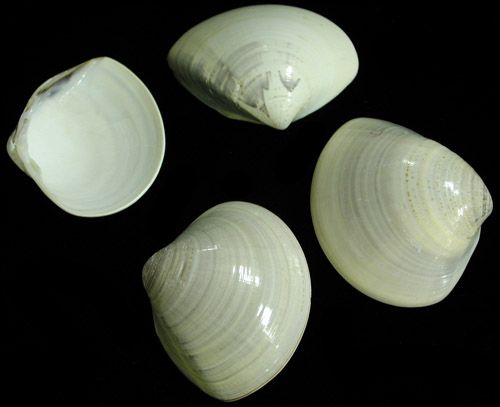One quarter pound of baby single Quahog Clam shells measuring 1.5 to 2.5 inches *****
One quarter pound of baby single Quahog Clam shells measuring 1.5 to 2.5 inches
Orders usually process within 2 to 5 business days.
Email us at ja1@mindspring.com Make Your Selections and Shipping Preference. We Will Email You the amount of the Shipping Cost. When you receive the shipping cost go back into Shells of Aquarius and click into Purchase Shipping Label. There you will find UPS or USPS. Click into the option you decided on and make your payment. Your order will ship when shipping payment is received.
Mercenaria mercenaria
common names hard clam, the round clam, hard-shell (or hard-shelled) clam, or the quahog.
The quahog is an edible marine bivalve mollusk that is native to the eastern shores of North America and Central America from Prince Edward Island to the Yucatán Peninsula. It is one of many unrelated edible bivalves that in the United States are frequently referred to simply as clams.In fish markets, there are specialist names for different sizes of the quahog clam. The smallest legally harvestable clams are called countnecks or peanuts, next size up are littlenecks, then topnecks. Above that are the cherrystones, and the largest are called quahogs or chowder clams.
Hard clams or quahogs are quite common throughout New England, north into Canada, and all down the Eastern seaboard of the United States to Florida; but they are particularly abundant between Cape Cod and New Jersey, where seeding and harvesting them is an important commercial form of aquaculture.
Historically, Native Americans used the quahog as a component in wampum, the shell beads exchanged in the North American fur trade. The Narragansetts used the hard clam for food and ornaments.
Rhode Island is situated right in the middle of "quahog country" and has supplied a quarter of the U.S.'s total annual commercial quahog catch. The quahog is the official shellfish of the U.S. state of Rhode Island. The species has also been introduced and is farmed on the Pacific coast of North America and in Great Britain and continental Europe. It reproduces sexually by females and males shedding gametes into the water.
The term "red tide" refers to an accumulation of a toxin, such as saxitoxin, produced by marine algae. Filter-feeding shellfish are affected, such as clams, oysters, and mussels. The toxin affects the human central nervous system. Eating contaminated shellfish, raw or cooked, can be fatal. Some other kinds of algal blooms make the seawater appear red, but red tide blooms do not always discolor the water, nor are they related to tides.
Scientific classification
Domain: Eukaryota
Kingdom: Animalia
Phylum: Mollusca
Class: Bivalvia
Order: Venerida
Superfamily: Veneroidea
Family: Veneridae
Genus: Mercenaria
